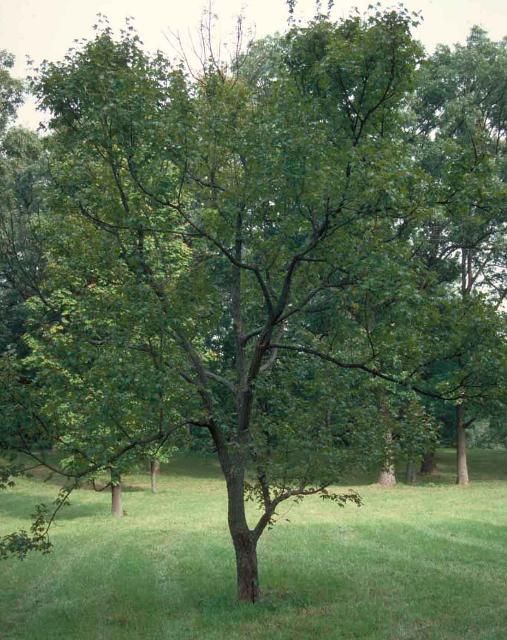Introduction
Hedge maple is usually low-branched with a rounded form, but there is considerable variability from one tree to the next. The branches are slender and branch profusely, lending a fine texture to the landscape particularly during winter. Lower branches can be removed to create clearance beneath the crown for vehicles and pedestrians. The tree eventually reaches a height and spread of 30 to 35 feet but it grows slowly. The small stature and vigorous growth make this an excellent street tree for residential areas, or perhaps in downtown urban sites. However, it grows a little too tall for planting beneath some power lines. It is also suitably as a patio or yard shade tree because it stays small and creates dense shade. The leaves of this cultivar emerge yellowish and gradually change to green in the summer.

Credit: Ed Gilman
General Information
Scientific name: Acer campestre
Pronunciation: AY-ser kam-PESS-tree
Common name(s): 'Postelense' hedge maple
Family: Aceraceae
USDA hardiness zones: 5A through 8A (Fig. 2)
Origin: not native to North America
Invasive potential: little invasive potential
Uses: highway median; parking lot island < 100 sq. ft.; parking lot island 100-200 sq. ft.; parking lot island > 200 sq. ft.; urban tolerant; specimen; street without sidewalk; deck or patio; shade; screen; hedge; trained as a standard; sidewalk cutout (tree pit); tree lawn 3-4 feet wide; tree lawn 4-6 feet wide; tree lawn > 6 ft. wide; Bonsai
Availability: somewhat available, may have to go out of the region to find the tree

Description
Height: 30 to 35 feet
Spread: 30 to 35 feet
Crown uniformity: symmetrical
Crown shape: round
Crown density: dense
Growth rate: slow
Texture: fine
Foliage
Leaf arrangement: opposite/subopposite (Fig. 3)
Leaf type: simple
Leaf margin: undulate, lobed
Leaf shape: star-shaped
Leaf venation: palmate
Leaf type and persistence: deciduous
Leaf blade length: 2 to 4 inches
Leaf color: yellow
Fall color: yellow
Fall characteristic: showy

Flower
Flower color: green
Flower characteristics: not showy
Fruit
Fruit shape: oval
Fruit length: 1 to 3 inches
Fruit covering: dry or hard
Fruit color: brown, green
Fruit characteristics: does not attract wildlife; not showy; fruit/leaves not a litter problem
Trunk and Branches
Trunk/bark/branches: branches droop; not showy; typically one trunk; thorns
Pruning requirement: needed for strong structure
Breakage: resistant
Current year twig color: brown
Current year twig thickness: thin, medium
Wood specific gravity: unknown
Culture
Light requirement: full sun, partial sun or partial shade
Soil tolerances: sand; loam; clay; acidic; slightly alkaline; well-drained
Drought tolerance: high
Aerosol salt tolerance: moderate
Other
Roots: not a problem
Winter interest: yes
Outstanding tree: yes
Ozone sensitivity: unknown
Verticillium wilt susceptibility: susceptible
Pest resistance: free of serious pests and diseases
Use and Management
The tree excels in its ability to tolerate dry, alkaline soil but some protection from open winds is helpful. Not for highly compacted soil. It is well-suited for and looks great during drought in a partially shaded location or on the north side of a building. The common name alludes to the plant's tolerance of severe pruning, and it will make a dense, tall screen, whether pruned or not. Branches are arranged closely on the trunk and some pruning is usually desirable to create a well-formed tree. The main ornamental feature is the bright yellow fall color. There appears to be variability in color from one year to the next and from tree to tree. Prune early in the life of the tree to develop several major branches well-spaced along a central trunk. This will improve the durability of the tree compared to trees with many upright and spreading branches originating from one point on the trunk.
'Evelyn' may be more vigorous, has an upright branching habit but is cold tolerant only to USDA hardiness zone 6. 'Compactum' is dwarf.
Pests
Pests are usually not a problem but there are some potential problems.
Leaf stalk borer and petiole borer cause the same type of injury. Both insects bore into the leaf stalk just below the leaf blade. The leaf stalk shrivels, turns black, and the leaf blade falls off. The leaf drop may appear heavy but serious injury to a healthy tree is rare.
Aphids infest maples, usually Norway maple, and may be numerous at times. High populations can cause leaf drop. Another sign of heavy aphid infestation is honey dew on lower leaves and objects beneath the tree. Aphids are controlled by spraying or they may be left alone. If not sprayed, predatory insects will usually bring the aphid population under control.
Scales are an occasional problem on maples. Perhaps the most common is cottony maple scale. The insect forms a cottony mass on the lower sides of branches. Scales are controlled with horticultural oil sprays. Scales may also be controlled with other well-timed sprays to kill the crawlers.
If borers become a problem it is an indication the tree is not growing well. Controlling borers involves keeping trees healthy. Chemical controls of existing infestations are more difficult. Proper control involves identification of the borer infesting the tree then applying insecticides at the proper time.
Diseases
Verticillium wilt symptoms are wilting and death of branches. Infected sapwood will be stained a dark or olive green, but staining can't always be found. If staining can not be found, do not assume the problem is not verticillium wilt. Severely infected trees probably can't be saved. Lightly infected trees showing only a few wilted branches may be pulled through. Fertilize and prune lightly infected trees. This treatment will not cure the problem but may allow the tree to outgrow the infection. Girdling roots will cause symptoms which mimic verticillium wilt.
Tar spot and a variety of leaf spots cause some concern among homeowners but are rarely serious enough for control.